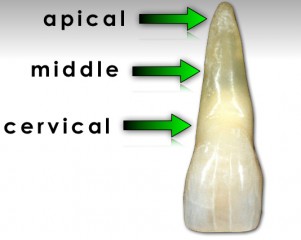Horizontal Root Fracture: Extract or Retain?
By Greggory Kinzer on August 24, 2017 |Imagine if this was your new patient:

The tooth was traumatically fractured and was bonded back in place with a Ribbond composite splint. The tooth is asymptomatic when you see her. What would you do? Would the discussion revolve around extraction and implant placement utilizing a small diameter implant or possibly a resin bonded bridge? Or would you just leave the tooth the way it is and monitor the patient over time? How predictable is a tooth like this long-term?

It is not uncommon for a tooth like this to be extracted by looking at and treating the radiographic appearance. However, if we look at the dental literature on the prognosis of horizontal root fractures, we may decide that the tooth should be retained.
A great piece of dental literature was done by Andreasen and his group where they looked at the survival of 534 incisors after intra-alveolar root fracture in patients aged 7-17. In the paper they classified the fracture location as cervical, cervical-middle, middle, and apical 1/3 (see image to left). It was found that 78 percent of the teeth showed healing of the fracture (either by hard tissue, fibrous, or osseous), with no difference between fracture positions on the root.
In 85 percent of the teeth, this healing remained unchanged throughout the control period with no post-healing complication. At 10 years there was an 80 percent survival rate. The highest frequency of tooth loss (70 percent) was with teeth that had cervical fracture locations. So, if you remove the teeth with cervical fracture locations, the 10-year success rate rose to 88 percent.
So when you look at the literature, there is a high degree of long-term success of teeth with horizontal fractures as long as the fracture isn't located in the cervical 1/3. This finding makes sense if you consider that the nearer the fracture is to the osseous crest, the less root is present in bone to support the crown of the tooth.
Looking at the image below, we can see that the fractured central incisor is still functional and serviceable at 13 years. Although this case is not the norm (because of the long-term success despite the location of the fracture being in the cervical 1/3), hopefully it makes you stop and think differently about managing teeth with horizontal root fractures.

(Click this link to read more dentistry articles by Dr. Gregg Kinzer.)
Gregg Kinzer, D.D.S., M.S., Spear Faculty and Contributing Author
References
Survival of 534 incisors after intra-alveolar root fracture in patients aged 7-17; Cvek M, Tsilingaridis G, Andreasen J; Dental Traumatol 2008 24;194(4):379-87